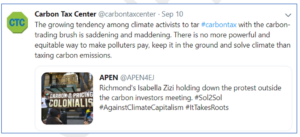Over the weekend the Washington Spectator published my essay, Diary of a Transit Miracle, recounting the arduous march of NYC congestion pricing from a gleam in a trio of prominent New Yorkers’ eyes at the end of the 1960s, to the verge of startup at the upcoming stroke of midnight June 30, the startup time announced by the MTA last Friday.
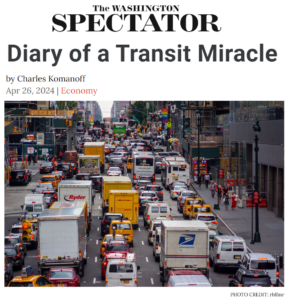
Landing page for this post’s original version.
I’m cross-posting it here — the third post on the subject in this space in the past 12 months (following this in December and this post last June) — because the advent of congestion pricing in the U.S. is “a really big deal,” as a number of friends and colleagues have told me in recent weeks. As my new essay makes clear, charging motorists to drive into the heart of Manhattan isn’t just a rejection of unconstrained motordom, it’s a new beachhead in “externality pricing” — social-cost surcharging — of which carbon taxes are the ultimate form.
The essay features two governors, two mayors — one of whom I served a half-century ago as a lowly but admiring data cruncher — a civic “Walter Cronkite,” a Nobel economist, raucous transit activists, a gridlock guru and yours truly, plus a cameo appearance by Robert Moses. It includes footage of the historic 1969 press conference in which Mayor John Lindsay and two distinguished associates enunciated the core idea of using externality pricing to better balance automobiles and mass transit that animated the arduous but ultimately triumphant congestion pricing campaign.
— C.K., April 29, 2024
Diary of a Transit Miracle
A miracle is coming to New York City. Beginning on July 1, and barring a last-minute hitch, motorists will soon pay a hefty $15 to enter the southern half of Manhattan — the area bounded by the Hudson River, the East River and 60th Street.
An anticipated 15 percent or so of drivers will switch to transit, unsnarling roads within the “congestion zone” and routes leading to it. The other 80 or 90 percent will grumble but continue driving. That is by design. The toll bounty, a billion dollars a year, will finance subway enhancements like station elevators and digital signals that will increase train throughput and lure more car trips onto trains.
The result will be faster, smoother commutes, especially for car drivers and taxicab and Uber passengers, who will pay a modest surcharge of $1.25 to $2.50 per trip. Drivers of for-hire vehicles will benefit as well, as lesser gridlock leads to more fares.1
The miracle is three-fold: Winners will vastly outnumber losers; New York will be made healthier, calmer and more prosperous; and that this salutary measure is happening at all, after a half-century of setbacks.
Obstacles to congestion pricing
Congestion pricing, as the policy is known, faced formidable obstacles even beyond the difficulty inherent in asking a group of people to start forking over a billion dollars a year for something that’s always been free.
Congestion pricing also had to contend with: an ingrained pro-motoring ideology that casts any restraint on driving as a betrayal of the American Dream; a general aversion to social-cost surcharges (what economists call “externality pricing”); exasperation over the region’s balkanized and convoluted toll and transit regimes; and, of late, a decline in social solidarity and appeals to the common good.
The advent of congestion pricing in New York is, thus, cause not just for celebration but wonderment. How did this wonky yet radical idea advance to the verge of enactment?
Origins
The trail begins in the waning days of 1969, when newly re-elected mayor John Lindsay recruited two well-regarded New Yorkers to devise a plan to fend off a 50 percent rise in subway and bus fares.
William Vickrey, a Canadian transplant teaching at Columbia and a future Nobel economics laureate, was a protean theorist of externality pricing. New York-bred mediator Theodore Kheel was admired as a civic Walter Cronkite for his plain-spoken common sense.
Lindsay, too often dismissed as a lightweight, understood mass transit as key to loosening automobiles’ spreading chokehold over the city. He had made combating air pollution a pillar of his first term and was fast becoming an exemplar of urban environmentalism. From his municipal engineers, Lindsay knew that technology to clean up tailpipes still lay in the future. A transit fare hike that would add yet more vehicles to city streets imperiled his clean-air agenda.
The triumvirate proposed a suite of motorist fees to preserve the fare. Their program ― higher registration fees and gasoline taxes, a parking garage tax, doubled tolls ― though mild in today’s terms, threatened powerful bureaucracies and their auto allies. Newly dethroned “master-builder” Robert Moses opined that Kheel, in his zeal to save the fare, had “gone berserk over bridge and tunnel tolls.”2 The program went nowhere.
L to R: Kheel, Lindsay, Vickrey. Click arrow to view (please excuse two brief garbled passages toward end).
Moses was right to be alarmed. From a City Hall podium on Dec. 16, 1969, Mayor Lindsay showcased Kheel’s and Vickrey’s respective reports, “A Balanced System of Transportation is a Must” and “A Transit Fare Increase is Costly Revenue.” (Click link in still photo above to view 27-minute video.) The trio propounded a new urban doctrine rebalancing automobiles and public transportation: “Automobiles are strangling our cities… Starving mass transit imposes costs that are difficult to measure, yet real… Correcting the fiscal imbalance between transit and the automobile is key to enhancing our environment and quality of life…”
Their remarks set generations of urbanists on course toward congestion pricing.
Setbacks
Quantifying those precepts became my research agenda 40 years later. In the interim, two creditable attempts to enact congestion pricing crashed and burned.
The central element of Lindsay’s 1973 “transportation control plan” was tolls on the city’s East River bridges, a measure designed to eliminate enough traffic to satisfy federal clean-air standards. Though the plan’s formal demise didn’t come until 1977, in legislation written by liberal lawmakers from Brooklyn and Queens, the toll idea never stood a chance. Electronic tolling was 20 years away, and adding stop-and-go toll booths seemed more likely to compound vehicular exhaust than to cut it.
Three decades later, in 2007, Mayor Michael Bloomberg asked Albany to toll not just the same East River bridges but also the more-trafficked 60th Street “portal” to mid-Manhattan. Predictably, faux-populist legislators saw Bloomberg’s billionaire wealth as an invitation to denounce the congestion fee as an affront to the little guy.
The mayor may have hurt his cause by presenting congestion pricing primarily as a climate and pollution measure. The pollution rationale was no longer compelling in the way it had been in Lindsay’s day, as automotive engineers had slashed rates of toxic vehicle exhaust ten-fold. Appeals tied to global warming also fell flat; remember, congestion pricing contemplated that most drivers would stay in their fossil-fuel burning cars.
This isn’t to say that congestion pricing confers no climate benefits. Rather, the benefits are subtler ones that can be hard to convey to voters, such as making climate-friendly urban living more attractive. A further benefit may come as congestion pricing demonstrates the unique power of externality pricing, as explained below.
From the Rubble
Even as Bloomberg’s toll plan was faltering in Albany, new loci of support were germinating in the city.
Changing times demanded not just the intellectual leadership of think-tanks like the Regional Plan Association and the good-government Straphangers Campaign, but gritty, grassroots transit organizing. Enter the newly-minted Riders Alliance.
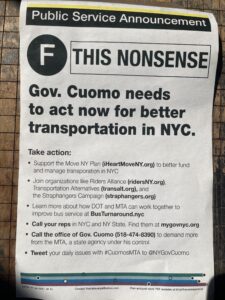
2017 subway handbill exemplified new militancy targeting Gov. Andrew Cuomo for failing transit.
As subway service began cratering in 2015, the inevitable result of budget-raiding by a skein of governors, the Alliance posted crowd-sourced photos of stalled trains and jammed platforms alongside demands for improved service from “#CuomosMTA.” Before long, the papers were pointing the finger at the governor not just in “Why Your Commute Is Bad” explainers but in tear-jerkers like the Times’ May 2017 classic, “Money Out of Your Pocket”: New Yorkers Tell of Subway Delay Woes.
The drumbeat was deafening. Cuomo finally blinked. On a Sunday in August 2017, he phoned the Times’ Albany bureau chief and handed him a scoop for the next day’s front page: Cuomo Calls Manhattan Traffic Plan an Idea ‘Whose Time Has Come’.
The “traffic plan” was congestion pricing.
Data Cruncher
Two months later, Cuomo’s staff summoned me to the midtown office of the consulting firm they had retained to “scope” congestion pricing ― essentially, to compute how much revenue tolls could generate. They wanted to see if an Excel spreadsheet model I had constructed and refined over the prior decade could aid their scoping process.
The model was called the Balanced Transportation Analyzer, a name bestowed in 2007 by Ted Kheel.
Ted, in his nineties, had recruited me to determine whether a large enough congestion toll could pay to make city transit free. The idea worked on paper but foundered politically. Nevertheless, Ted saw in my Excel modeling a way to capture phenomena like “rebound effects” (motorists driving more as road space frees up) and “mode switching” between cars, trains, buses and taxicabs, that he and Prof. Vickrey had identified in their 1969 work but lacked the computing ability to quantify.
Ted’s philanthropy enabled me over the next decade to expand, test and update my transportation modeling. With a hundred “tabs” and 160,000 equations, the “BTA” can instantly answer almost any conceivable question about New York congestion pricing, as well as these two central ones: how much revenue it will yield, and how much time will travelers save in lightened traffic and better transit.3
The BTA model aced its 2017 audition and became the computational engine for the congestion pricing legislation the governor’s team enacted into law in 2019. Its impact has been even broader.4 “Having the model helped make the case with the public, journalists, elected officials and others,” Eric McClure, director of the livable-streets advocacy group StreetsPAC, wrote recently, in part by helping congestion pricing proponents push back on opponents’ exaggerated claims of disastrous outcomes and their incessant demands for special treatment. The model may also have influenced the detailed toll design adopted by the MTA board earlier this year, which hewed close to the toll design I had recommended last summer.5
The BTA also provided sustenance during congestion pricing’s seven lean years ― the 2009-2016 period in which the torch was kept lit by a new triumvirate known as “Move NY” ― traffic guru “Gridlock” Sam Schwartz, the very able campaign strategist Alex Matthiessen, and myself. The model helped our team evangelize congestion pricing’s transformative benefits to elected officials and the public. This, I believe, was a key element in mustering the critical mass of support that ultimately swayed not one but two governors.
The Hochul Factor
New York Lieutenant Governor Kathy Hochul’s ascension to governor in August 2021 could have been congestion pricing’s death knell. The toll plan was adrift in the federal bureaucracy, and its latter-day champion Andrew Cuomo had exited in “me-too” disgrace. His successor, from distant Buffalo, wasn’t beholden to New York or congestion pricing.
Hochul, who as governor controls city and regional transit, could have disowned congestion pricing as convoluted, bureaucratic and tainted. Instead, she became a resolute and enthusiastic backer. Her spirited support, both in public and behind the scenes, became the decisive ingredient in shepherding congestion pricing to safety.
Why the new governor went all-in on congestion pricing awaits a future journalist or historian. Had she spurned it, the opprobrium from downstate transit advocates would have been intense; but there doubtless would have been cries of “good riddance” as well. Vickrey, Kheel and Riders Alliance notwithstanding, it’s not clear how closely New Yorkers — including transit users — connect congestion tolls to improved travel and a better city.
What makes Hochul’s embrace especially impressive is that congestion pricing is, in a real sense, an attack on a jealously guarded entitlement: the right to inconvenience others by usurping public space for one’s vehicle. The classic lament about entitlements’ iron grip is that “losers cry louder than winners sing.”6 Yet in this case, it seems, potential losers — actual and aspiring zone-bound drivers — are being out-sung by transit interests seeking, in Kheel’s 1969 words, a better balance between public transportation and automobiles.
Credits and Prospects
Let us now praise Andrew Cuomo’s crafting of the legislation that teed up congestion pricing’s successful run.
Rather than specifying a dollar price for the tolls, or a precise traffic reduction, his 2019 bill established a revenue target: sufficient earnings to bond $15 billion in transit investment — which equates to $1 billion a year to cover debt service. This device trained the public’s focus on the gain from congestion pricing (better transit) instead of the pain (the toll). Equally important, with this deft stroke, any toll exemption that a vocal minority might seek would mathematically trigger higher tolls for everyone else. The effect was vastly heightened scrutiny of requests for carve-outs.
Which cities will follow on New York’s heels? No U.S. urban area comes close to our trifecta of gridlock, transit and wealth. Sprawling Los Angeles or Houston, or even Chicago for that matter, might be better served by more granulated traffic tolls than New York’s all-or-none model.
Perhaps Asia’s megalopolises will be swept up in our wake. In the meantime, my focus will be on the holy grail of externality pricing: taxing carbon emissions. Every economist knows that the surest and fastest way to cut down on a “bad” is by taxing it rather than subsidizing possible alternatives. Yet that approach remains counter-intuitive and even anathema to nearly everyone else.
A huge and important legacy that New York congestion pricing could provide is to prove that intelligently taxing societal harms need not be electoral suicide. This proof could help unlock a treasure-trove of prosperity-enhancing pricing reforms including, most prominently, robust carbon taxing.
The author, a policy analyst based in New York City, worked in Mayor Lindsay’s Environmental Protection Administration in 1972-1974. He met Bill Vickrey in 1991 and worked closely with Ted Kheel from 2007 to 2010.
Endnotes
- The new passenger surcharges of $1.25 for taxicabs and $2.50 for “ride-hails” (principally Ubers) apply to trips touching the congestion zone. These will be partially offset by lower fares owing to shorter wait-time charges due to faster travel speeds.
- Quote is from Moses’ August 23, 1969 guest essay in Newsday, “Is Rubber to Pay for Rails?” (not digitally available).
- The current version of the BTA is publicly available at this link: (18 MB Excel file).
- See Fix NYC Advisory Panel Report, Appendix B, 2019.
- A Congestion Toll New York Can Live With, July 2023, by Charles Komanoff, co-authored with Columbia Business School economist Gernot Wagner.
- As pronounced by University of Michigan economist Joel Slemrod, in Goodbye, My Sweet Deduction, New York Times, by Eduardo Porter and David Leonhardt, Nov. 3, 2005.

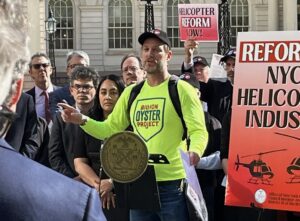

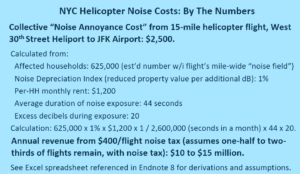
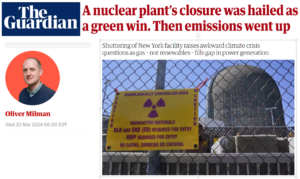
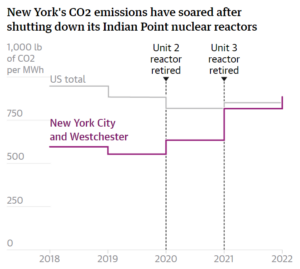
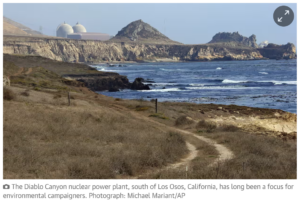 “Diablo Canyon has not received the safety upgrades and maintenance it needs and we are dubious that nuclear is safe in any regard, let alone without these upgrades – it’s a huge problem,” said Hallie Templeton, legal director of Friends of the Earth, which was founded in 1969 to, among other things, oppose Diablo Canyon.
“Diablo Canyon has not received the safety upgrades and maintenance it needs and we are dubious that nuclear is safe in any regard, let alone without these upgrades – it’s a huge problem,” said Hallie Templeton, legal director of Friends of the Earth, which was founded in 1969 to, among other things, oppose Diablo Canyon.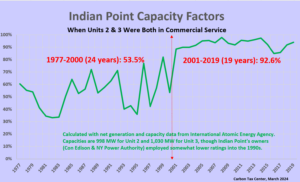
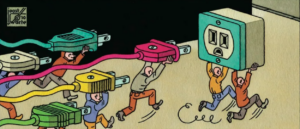
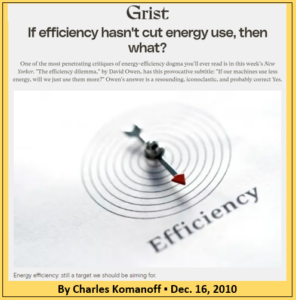 Owen’s thesis is that as a society becomes more energy efficient, it becomes downright inefficient not to use more. The pursuit of efficiency is smart for individuals and businesses but a dead end for energy and climate policy.
Owen’s thesis is that as a society becomes more energy efficient, it becomes downright inefficient not to use more. The pursuit of efficiency is smart for individuals and businesses but a dead end for energy and climate policy.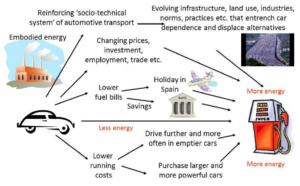
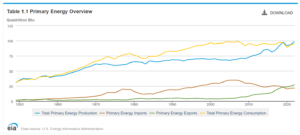
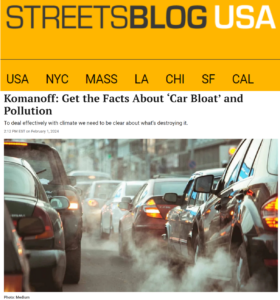
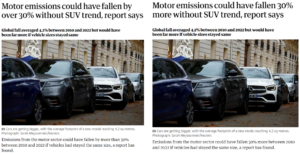
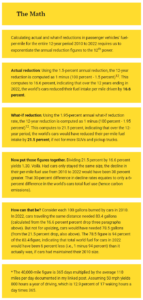
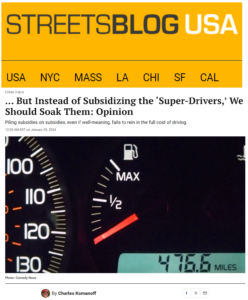 One-tenth of American motorists, we’ve just learned, consume more than a third of U.S. gasoline.
One-tenth of American motorists, we’ve just learned, consume more than a third of U.S. gasoline.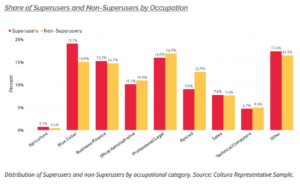
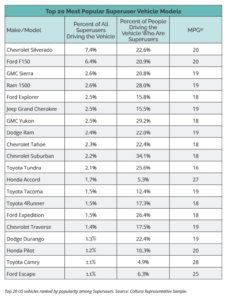
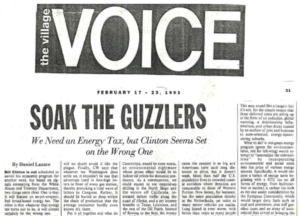
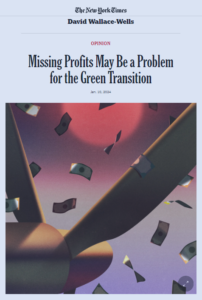
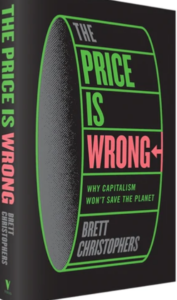
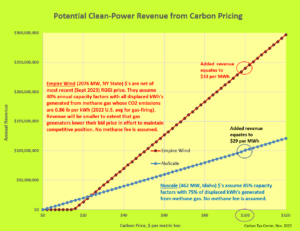
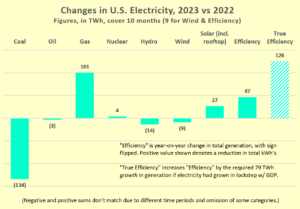 Here we examine the locus of the good news: the 8% drop in electricity generation in 2023 vs. 2022 that enabled the 2% drop in overall emissions despite rises in emissions from transportation and some other sectors.
Here we examine the locus of the good news: the 8% drop in electricity generation in 2023 vs. 2022 that enabled the 2% drop in overall emissions despite rises in emissions from transportation and some other sectors.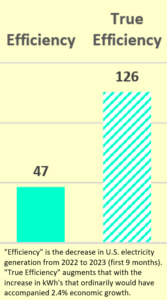 But the efficiency story doesn’t end there. U.S. economic output wasn’t flat in 2023, it grew by 2.4% over 2022 (per preliminary figures
But the efficiency story doesn’t end there. U.S. economic output wasn’t flat in 2023, it grew by 2.4% over 2022 (per preliminary figures 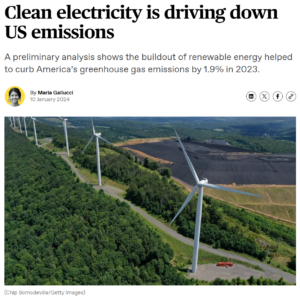

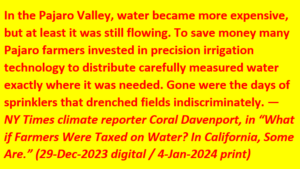 Just as importantly, the growers receive a potent incentive to use available water supplies more efficiently. “Gone were the days of sprinklers that drenched fields indiscriminately,” Davenport writes. “To save money, many Pajaro farmers invested in precision irrigation technology to distribute carefully measured water exactly where it was needed.” (See text box.) Though the article doesn’t mention it, these investments by dozens of individual growers might not have materialized had not all growers been subject to the same incentives to conserve as well.
Just as importantly, the growers receive a potent incentive to use available water supplies more efficiently. “Gone were the days of sprinklers that drenched fields indiscriminately,” Davenport writes. “To save money, many Pajaro farmers invested in precision irrigation technology to distribute carefully measured water exactly where it was needed.” (See text box.) Though the article doesn’t mention it, these investments by dozens of individual growers might not have materialized had not all growers been subject to the same incentives to conserve as well.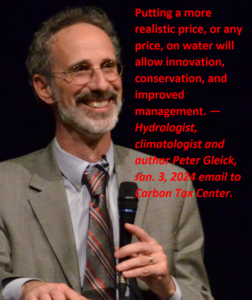 After reading Davenport’s article I reached out to hydrologist, climatologist and water sustainability expert Peter Gleick, whose latest book,
After reading Davenport’s article I reached out to hydrologist, climatologist and water sustainability expert Peter Gleick, whose latest book, 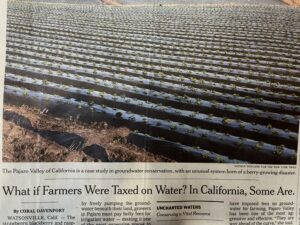
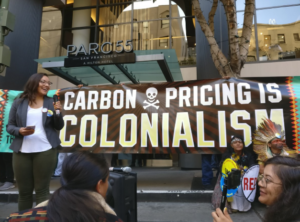
 Suppose carbon emissions were taxed in every country. Would that entail colonizing of poor nations by the rich? It could, but only if the carbon-tax wealth — the revenue generated by the tax on carbon emissions — was siphoned off by the rich countries.
Suppose carbon emissions were taxed in every country. Would that entail colonizing of poor nations by the rich? It could, but only if the carbon-tax wealth — the revenue generated by the tax on carbon emissions — was siphoned off by the rich countries.